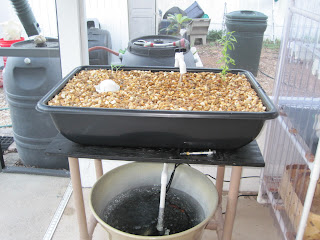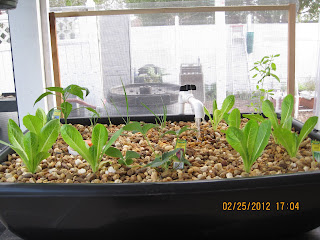 |
| Started on 2/14/12 - Joni's Valentine's present... |
Living in sunny Florida can be a challenge when it comes to growing vegetables successfully. There are bugs, torrential rains, heat and sand instead of dirt… just to mention a few of the challenges! We have Earth Boxes, No-Dig gardens, Auto-Pots, Square Foot Gardening (raised beds) and Hydroponic systems. Each has their advantages and disadvantages and we will cover each of these in future posts.
Not having a 100% success rate with any of the above systems, I began to look for yet another way of growing food. This is when I came across Aquaponics. After doing a little research I decided to give Aquaponics a try. There is a wealth of information on the internet and several websites that have been very helpful. (I will list the links at the end of this article.) There are a number of reasons for giving this a try. However, know going in that there is a little more than just sticking a seed in and waiting for it to grow. By doing a little homework and reading, you can save yourself a bunch of headaches and failures.
 |
| Everything is thriving... |
First, I decided to go with a growbed 2 feet by 3 feet by 8 inches deep which gives 6 square feet of growing space. Perfect for a patio salad garden! Those familiar with square foot gardening will appreciate this. As with a square foot garden, my research revealed that you can grow more plants in a smaller space with Aquaponics. I purchased a mixing tray from Lowes. Most of the research suggested a depth of at least 10 inches, but I couldn’t find one that met these measurements so I went with what was available. So far - no regrets with this tray.
The growing media for our tray is a mixture of Hydroton (expanded clay balls used in soilless growing systems) and pea gravel. You can use lava rock as well. It is important to make sure the media you choose doesn’t have limestone in it, because it makes the Ph too high. You can test the grow media by placing a little of it in white vinegar – if it bubbles then there is limestone in the mix!
Next, you will need something for the fish. The system is on our patio, so I wanted something that was pleasing to the eye. I purchased a large planter pot which held about thirty gallons of water. PVC pipe and fittings round out the main components of our system. All that was left was to add a few gold fish, air stone, pond pump and presto – we were in business.
 |
| After a month of growth...we added strawberries to the mix! |
This article is intended to give you a glance at our first system….please use the references below to further explore this grow method… We will post a detailed description as we build our next system… Yes, we are already planning a bigger one! With Tilapia….and solar power…and….ah, to dream…
~Jerry
RESOURCES:
http://aquaponicscommunity.com/ Great forum - knowledgeable and helpful
growers.
http://www.aces.edu/dept/fisheries/education/documents/barrel-ponics.pdf Free eBookhttp://www.backyardaquaponics.com Plenty of info on basics with people ready to help!
Pin It





